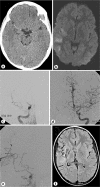Systemic thrombolytic therapy alone and in combination with mechanical revascularization in acute ischemic stroke in two children
- PMID: 21532986
- PMCID: PMC3084039
- DOI: 10.1159/000327554
Systemic thrombolytic therapy alone and in combination with mechanical revascularization in acute ischemic stroke in two children
Abstract
Thrombolytic therapy is not recommended for acute ischemic stroke (AIS) in patients under the age of 18 and published experience is limited. In this case report, we describe two children treated with systemic thrombolytic therapy. One child received additional mechanical revascularization and achieved a good clinical outcome. The differences in the fibrinolytic system and the different etiology of AIS in childhood may limit a simple extrapolation of the adult guidelines for systemic thrombolytic therapy. Acute multimodal imaging to clarify the etiology of AIS might help to select the most appropriate treatment modality.
Keywords: Acute stroke; Endovascular technique; Thrombolytic therapy.
Figures


References
-
- Tissue plasminogen activator for acute ischemic stroke. The National Institute of Neurological Disorders and Stroke rt-PA Stroke Study Group. N Engl J Med. 1995;333:1581–1587. - PubMed
-
- Hacke W, Kaste M, Bluhmki E, Brozman M, Davalos A, Guidetti D, et al. Thrombolysis with alteplase 3 to 4.5 hours after acute ischemic stroke. N Engl J Med. 2008;359:1317–1329. - PubMed
-
- Smith WS, Sung G, Starkman S, Saver JL, Kidwell CS, Gobin YP, Lutsep HL, Nesbit GM, Grobelny T, Rymer MM, Silverman IE, Higashida RT, Budzik RF, Marks MP. Safety and efficacy of mechanical embolectomy in acute ischemic stroke: results of the MERCI trial. Stroke. 2005;36:1432–1438. - PubMed
-
- Roach ES, Golomb MR, Adams R, et al. Management of stroke in infants and children: a scientific statement from a Special Writing Group of the American Heart Association Stroke Council and the Council on Cardiovascular Disease in the Young. Stroke. 2008;39:2644–2691. - PubMed
-
- European Stroke Organisation (ESO) Executive Committee, ESO Writing Committee Guidelines for management of ischaemic stroke and transient ischaemic attack 2008. Cerebrovasc Dis. 2008;25:457–507. - PubMed
Publication types
LinkOut - more resources
Full Text Sources

